Journal of Agricultural Science and Food Research
Open Access
ISSN: 2593-9173
ISSN: 2593-9173
Original Research Article - (2023)Volume 14, Issue 4
This study was carried out from 9/2022 to 2/2023, at Can Tho University, Vietnam. This study evaluated seedling stages’ salt tolerance in nutrient solution using three Electrical Conductivity (EC) salt concentrations of 9.38, 12.50, and 15.63 dS/m with fifteen traditional rice varieties. Five traditional salt-tolerant rice varieties at the seedling stage (level 5) at 15.63 dS/m were selected. Furthermore, we evaluated salt tolerance at EC 9.38, 12.50, and 15.63 dS/m in the vegetative and reproductive stages of seven rice varieties (a tolerant variety, Doc Phung, a sensitive variety, IR28, and five rice salt-tolerant varieties were selected at seedling stage). This study showed that an increase in EC concentrations in the soil significantly reduced plant height, panicle/plant, panicle length, a 1000 grain weight, and yield. The addition of 9.38 dS/m EC can distinguish tolerance and sensitive genotypes. The grain yield of sensitive genotypes decreased by 90%-100% at 9.38 dS/m EC, whereas the tolerant genotypes showed <60% in grain yield reduction. Selected traditional rice varieties of Nang Cha Ran, Nep Than, Trang Lun, Gie Hanh, and Nang Tich were salt tolerant at their seedling stage and vegetative and reproductive stages were at EC 9.38 dS/m.
Reproductive stages; Seedling stage; Traditional rice; Vegetative stage; Mekong delta
Compared to all the abiotic stresses, salt stress is the most complex, presenting a significant obstacle to preserving global food supplies and food security. For food security and sustainability in saltaffected environments, it is necessary to boost rice productivity in these soils. A micro core of 1500 lines has been generated, and the pass port data of 9000 rice germplasm has been established for 30 characteristics. For both the seedling and reproductive stages, about 20,000 rice lines have been examined for salinity and sodicity. In breeding programs, the highly tolerant rice lines are employed to increase genetic variety [1].
Some research suggest that rice is salt tolerant during germination, becomes susceptible during the early seedling stage (stages 2-3 leaves), enhances durability in the vegetative growth stage, becomes sensitive during pollination and fertilization, and becomes more adaptable as adults [2]. However, other research suggests that in the flowering stage, rice is not salt sensitive [3]. While farming rice in coastal areas, it was observed that salinity occurred in all rice growth stage. Therefore, it became essential to determine the response to rice plants’ salinity during the growing period.
For years, farmers have chosen and maintained traditional rice landraces in salt-affected areas despite their many undesirable characteristics, such as a longer maturation period, a low yield, and poor grain quality, just because of their remarkable resistance to salt stress. The salt tolerance of these landraces has been attributed to a number of physiological mechanisms, such as sodium exclusion, efficient storage of hazardous salts into older leaves and roots, and stimulation of the antioxidant system during stress. In addition to causing crop failure, high-yielding varieties developed with the objective of enhancing productivity also contributed to the genetic degradation of traditional landraces. Crop rotation, the application of green manure, and traditional farming techniques were common practices among farmers in the past. However, the younger generation is now unprepared to deal with saltwater soil and is oblivious of the use of other crops or techniques to tide things over [4,5].
Thus, to understand the response of rice plants to salinity as a whole, the stages of its development must be observed, namely, early seedling, vegetative, and reproductive stages. Therefore, this study evaluated the response of some seasonal rice varieties at different Sodium Chloride (NaCl) concentrations by observing morphological characteristics in saline soils. The difference in response would be a useful indicator when assessing the salt tolerance of seasonal rice varieties grown in saline soil under greenhouse conditions to select traditional rice varieties with salinity tolerance ≥ 9,38 dS/m.
This study was carried out for one season from 9/2022 to 2/2023, at the plant breeding laboratory, Can Tho University, Vietnam. Fifteen traditional rice varieties were used in this study, such as: Nang Cha Ran, Huyet Rong, Nang Cha, Nep Than, Nang Quot, Nang Thom, Nho Thom, Thang Con, Trang Lun, Lem Bui, Gie Hanh, Nang Tich, Mashuri, Can Lun, Nang Thom Cho Dao and Doc Phung was tolerance, IR28 was sensitive.
The first experiment was to evaluate the salinity tolerance of 15 traditional rice varieties at the seedling stage in a nutrient solution supplemented with three salinity concentrations of 9.38, 12.50, and 15.63 dS/m. After selecting rice varieties with salinity tolerance at the seedling stage at Electrical Conductivity (EC) of 15.63 dS/m from level 5 and up in the first experiment.
The second experiment was conducted to evaluate the salt tolerance at the vegetative and reproductive stages. The experiment had a completely randomized two-factor design with three repetitions. The first factor consists of five rice varieties selected in the first experiment. The second factor was EC concentrations at 0, 9,38, 12,50, and 15,63 dS/m. Rice seeds were sown in a plastic container filled with soil under non-saline condition for 21 days. Then, NaCl was added to the soil in each experiment by preparing a salt solution corresponding to each salinity concentration. The observed indicators were agronomic characteristics and yield components, such as plant height, panicle/plant, panicle length, and a 1000 grain weight and yield. These parameters were observed at the vegetative and reproductive stages.
All data were analyzed by analysis of variance using SPSS v.22.0. Test of variance was performed by Duncan’s test with a 5% significance level.
Time and place of the study
This study was carried out from 9/2022 to 2/2023, at Can Tho University, Vietnam.
The first experiment: evaluation of salt tolerance at the seedling stage
The results of salt tolerance evaluation at the seedling stage of seventeen rice varieties were tested at 9,38, 12,5, and 15,63 dS/m. It was revealed that the IR28 standard control variety was evaluated at level nine, an infected level. Five varieties, Nang Cha Ran, Nep Than, Trang Lun, Gie Hanh, and Nang Tich, were evaluated at three salt tolerance levels (9.38, 12.5, and 15.63 dS/m) (Table 1).
| STT | Rice varieties | Salt tolerance (level) | ||
|---|---|---|---|---|
| 9,38 dS/m | 12,5 dS/m | 15,63 dS/m | ||
| 1 | Nang Cha Ran | 1 | 3 | 3 |
| 2 | Huyet Rong | 5 | 5 | 7 |
| 3 | Nang Cha | 3 | 5 | 5 |
| 4 | Nep Than | 1 | 3 | 3 |
| 5 | Nang Quot | 5 | 5 | 7 |
| 6 | Nang Thom | 5 | 7 | 7 |
| 7 | Nho Thom | 5 | 7 | 7 |
| 8 | Thang Con | 3 | 5 | 5 |
| 9 | Trang Lun | 3 | 3 | 3 |
| 10 | Lem bui | 3 | 3 | 5 |
| 11 | Gie hanh | 3 | 3 | 3 |
| 12 | Nang tich | 3 | 3 | 3 |
| 13 | Mashuri | 5 | 7 | 7 |
| 14 | Can Lun | 3 | 3 | 5 |
| 15 | Nang thom cho đao | 3 | 5 | 7 |
| 16 | Doc phung (tolerance) | 3 | 3 | 5 |
| 17 | IR28 (sensitive) | 9 | 9 | 9 |
Table 1: Salt tolerance of the fifteen rice varieties tested.
The second experiment: evaluation of salt tolerance in vegetative and reproduction stages
Evaluation of rice salt tolerance is usually conducted in a greenhouse at the seedling stage. Through the assessment of agronomic characteristics, yield components and yield, the salt tolerance of the five rice varieties were determined. In IR28, no yield was recorded from EC 9,38 dS/m. The agronomic characteristics, yield composition, and yield of the varieties are shown in Table 2. The average of all details of rice, salinity EC (S), varieties (G), and S*G’s interaction are different at the 5% statistical significance level (Table 2).
| Source of variation | Df | Plant height | Panicle/plant | Panicle length | Grain/ | A 1000-grain weight | Yield/ |
|---|---|---|---|---|---|---|---|
| panicle | plant | ||||||
| Genotypes (G) | 6 | 2662,6* | 34,1* | 502,3* | 13395,6* | 332,1* | 93,8* |
| EC (S) | 3 | 2781,0* | 93,7* | 131,3* | 6961,3* | 420,0* | 2257,1* |
| S*G | 18 | 772,6* | 2,2* | 45,2* | 1003,7* | 59,7* | 10,0* |
| Error | 56 | 1,00 | 0,27 | 0,14 | 7,99 | 2,89 | 0,17 |
| CV (%) | 0,98 | 10,4 | 1,86 | 3,57 | 9,67 | 5,21 |
Note: CV: Coefficient of Variation; EC: Electrical Conductivity, *: Difference at the 5% level of statistical significance.
Table 2: Means square agronomic parameters, yield components, and yield of varieties at electrical conductivity concentrations.
Salinity significantly reduced the plant height of rice varieties at EC 9,38 dS/m, the standard variety infected with IR28 significant decreased in plant height with increasing salinity concentration, the remaining varieties and Doc Phung had an increased plant height and decreased salt concentration (Figure 1).
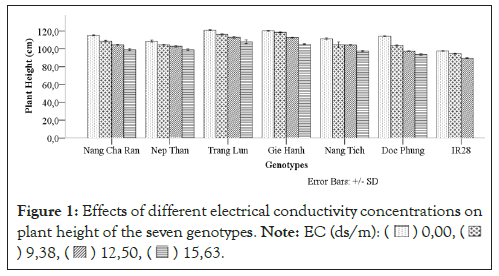
Figure 1: Effects of different electrical conductivity concentrations on
plant height of the seven genotypes. 

Panicle/plant was related to the tillering ability of rice plants. Here, salt significantly reduced panicle/plant compared with the control (0 dS/m). IR28 was not recorded in panicles exposed to salt treatments (Figure 2).
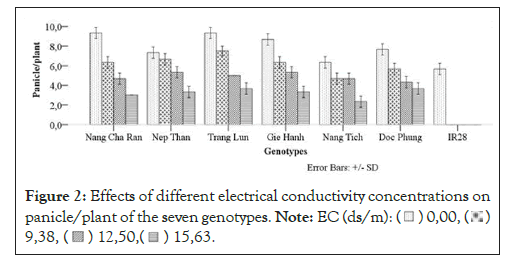
Figure 2: Effects of different electrical conductivity concentrations on
panicle/plant of the seven genotypes. 

Panicle length is an important yield component under salinity because it determines the number of seeds per panicle. Here, salinity reduced panicle length than the control (0 dS/m) and started decreasing at EC 9,38 dS/m. In standard varieties, IR28 was not recorded to influence the panicle length because the variety died at EC 9,38 dS/m, whereas Doc Phung salt-tolerant varieties had decreased panicle length from 22,1 cm to 20,0 cm (Figure 3).
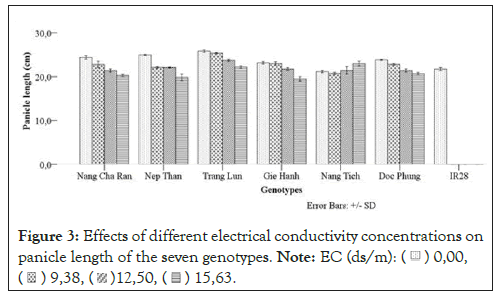
Figure 3: Effects of different electrical conductivity concentrations on
panicle length of the seven genotypes. 

The results of grain/panicle in Figure 4 show that grain/panicle decreased significantly as the EC concentration increased. For example, Nep Than had its grain/panicle reduced to 50% from 120 grains at EC 0 dS/m and had approximately 60 grains at EC 15,63 dS/m (Figure 4).
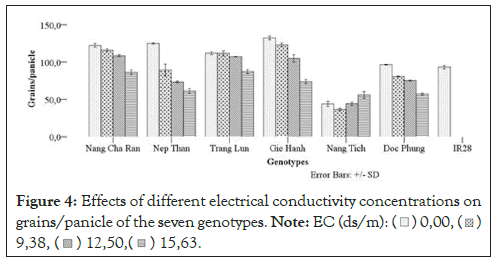
Figure 4: Effects of different electrical conductivity concentrations on
grains/panicle of the seven genotypes. 

Salt stress reduces a 1000 grain weight of all rice varieties from EC 9,38 dS/m. Doc Phung, Trang Lun, Gie Hanh had its 1000 grain weight insignificantly decrease; in contrast, the remaining varieties were significantly decreased (Figure 5).
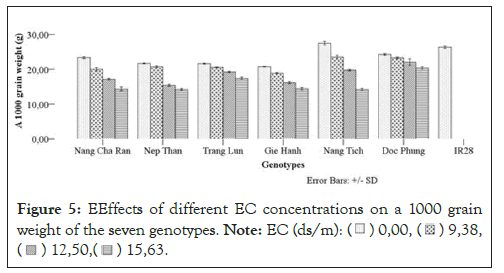
Figure 5: EEffects of different EC concentrations on a 1000 grain
weight of the seven genotypes. 

Grain yield depends on the number of panicle/plant, grains/ panicles, and a 1000 grain weight [6]. Here, a decrease in grain yield was observed in all rice varieties when EC increased from 9,38 to 15,63 dS/m (Table 3).
| EC (dS/m) | Yield/plant ± sd (g) | ||||||
|---|---|---|---|---|---|---|---|
| Nang Cha Ran | Nep Than | Trang Lun | Gie Hanh | Nang Tich | Đoc Phung | IR28 | |
| 0 | 27,9 ± 0,4a | 28,5 ± 0,2a | 23,7 ± 0,3a | 25,5 ± 0,2a | 30,2 ± 0,3a | 28,6 ± 0,1a | 25,6 ± 0,1a |
| 9,38 | 11,7 ± 0,2b | 11,4 ± 0,2b | 10,0 ± 0,3b | 10,6 ± 0,3b | 13,5 ± 0,3b | 13,5 ± 0,3b | 0,0 ± 0,0b |
| 12,5 | 8,5 ± 0,5c | 7,3 ± 0,2c | 5,3 ± 0,2c | 6,5 ± 0,2c | 9,5 ± 0,2c | 9,4 ± 0,3c | 0,0 ± 0,0b |
| 15,63 | 5,2 ± 0,3d | 5,4 ± 0,4d | 4,1 ± 0,2d | 4,8 ± 0,3d | 4,5 ± 0,2d | 5,6 ± 0,4d | 0,0 ± 0,0b |
Note: Means in the same column followed by the same letters are not significantly different at P=0.05, according to Duncan's test for multiple means.
Table 3: Grain yield (g) of five traditional rice varieties in differently electrical conductivity concentrations.
Grain yield reduction of rice varieties with increasing EC concentrations is shown in Figure 6. Grain yield at EC 9,38 dS/m declined significantly than the control (0 dS/m), what less than 40% for all rice varieties (Nang Cha Ran, Nep Than, Trang Lun, Nang Tich, and Doc Phung), whereas at EC 15,63 dS/m had decreased productivity of 80%. For IR28, only sensitive variety had their yield decreased by 100% at EC 9,38 dS/m (Figure 6) [7-9].
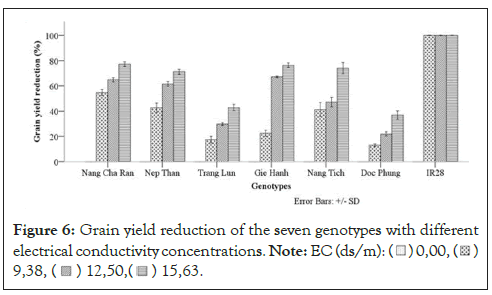
Figure 6: Grain yield reduction of the seven genotypes with different
electrical conductivity concentrations. 

Salt inhibited the growth of five traditional rice varieties from vegetative to reproductive stages causing reduced plant height, panicle/plant, panicle length, and a 1000 grain weight and yield. The relative reduction yield at EC 9,38 dS/m of the tolerant variety was less than 60%, whereas it was 100% for infected cultivars.
The selected five traditional rice varieties, namely, as Nang Cha Ran, Nep Than, Trang Lun, Gie Hanh, and Nang Tich expressed salinity tolerance in seedling, vegetative, and reproductive stages at EC 9,38 dS/m.
Tolerant and sensitive varieties could be distinguished at EC 9,38 dS/m, indicating that the NaCl at EC 9,38 dS/m in the growth medium could be used as a method to select resistant and infected varieties under greenhouse conditions.
Not applicable.
Not applicable.
Not applicable.
Not applicable.
The authors declare that there is no conflict of interest regarding the publication of this article.
Not applicable.
Not applicable.
This work was partially supported by CanTho university funded. We thank the Plant breeding and applied biotechnology Lab for providing rice genotypes for the project. We also thank the Plant Breeding Lab staff and students for the technical help and data collection.
[Crossref] [Google Scholar] [PubMed]
Citation: Lien QTA, Duy PVK (2023) Evaluation of Salt-tolerant Traditional Rice Varieties in Mekong Delta, Vietnam. J Agri Sci Food Res. 14:162.
Received: 24-Nov-2023, Manuscript No. JBFBP-23-26388; Editor assigned: 27-Nov-2023, Pre QC No. JBFBP-23-26388 (PQ); Reviewed: 13-Dec-2023, QC No. JBFBP-23-26388; Revised: 20-Dec-2023, Manuscript No. JBFBP-23-26388 (R); Published: 27-Dec-2023 , DOI: 10.35248/2593-9173.23.14.162
Copyright: © 2023 Lien QTA, et al. This is an open-access article distributed under the terms of the Creative Commons Attribution License, which permits unrestricted use, distribution, and reproduction in any medium, provided the original author and source are credited.